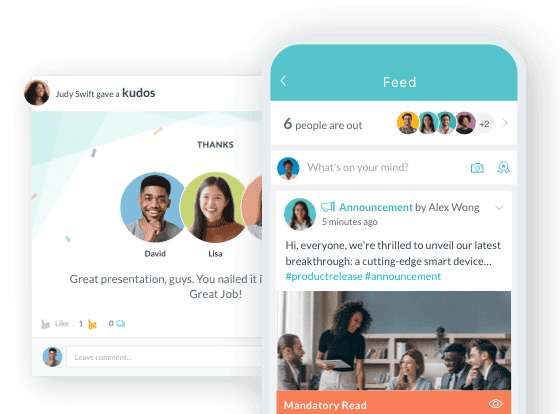10 Great Employee Recognition Examples from Top Companies (and How to Apply Them)
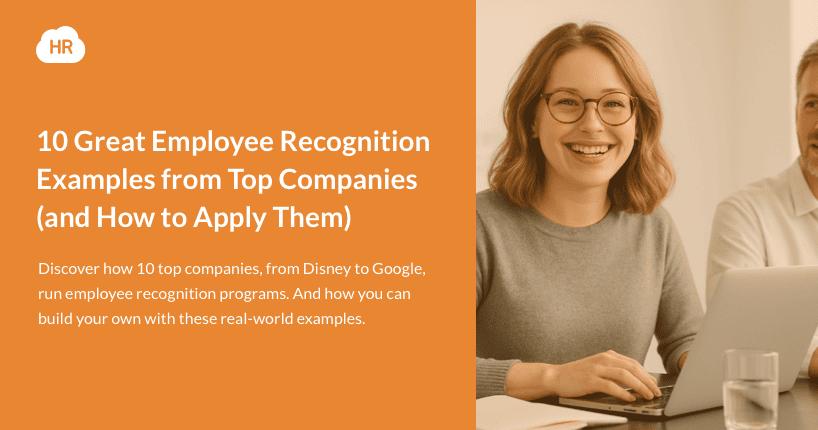
- Disney: Recognition Built Into Every Magical Moment
- Zappos: Culture-Fueled Peer Recognition
- Salesforce: Social, Visible, and Integrated Recognition
- Apple: Recognition Through Longevity and Quality
- Airbnb: Recognition Through Freedom, Travel, and Trust
- Hilton: Recognition Rooted in Hospitality
- Cisco: Peer Power Meets Performance
- Unilever: Recognition That Reflects a Global Workforce
- Mars: Everyday Recognition at Global Scale
- Google: Recognition That Fuels Innovation
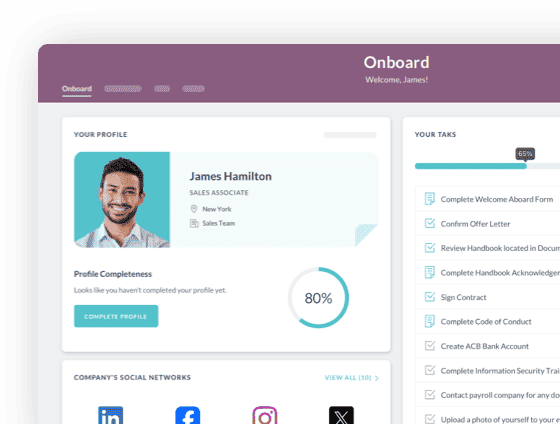
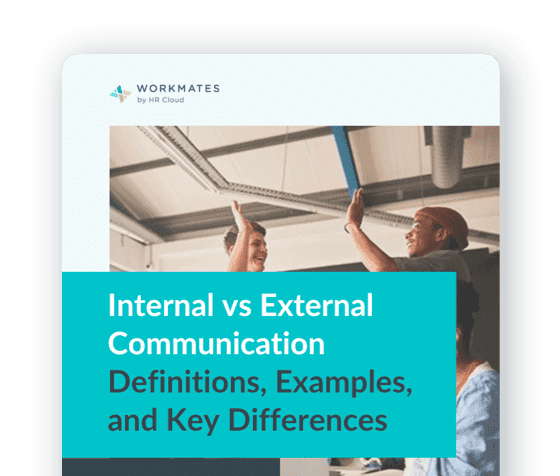
 Cut onboarding time
by 60%—here's the
Ultimate Checklist
that helped do it.
Cut onboarding time
by 60%—here's the
Ultimate Checklist
that helped do it.
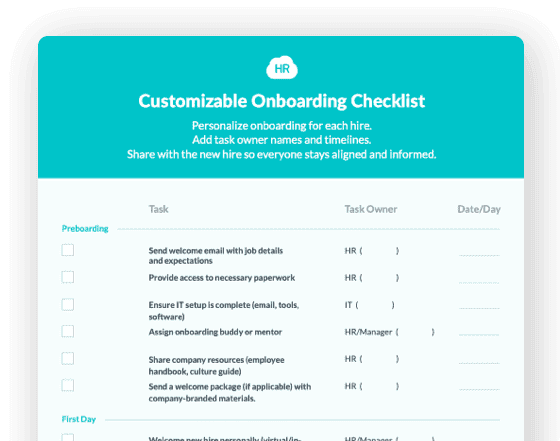
A survey of 16,000 professionals of all levels, across a variety of industries, undertaken by Deloitte suggests an intrinsic shift in the way employees wish to be recognized. They want recognition to be personalized, meaningful, and growth-oriented rather than generic or monetary.
- 85% of participants wanted to hear “thank you” in day-to-day interactions.
- Millennials want a growth opportunity paired with recognition
Employee recognition isn’t just a feel-good gesture for employees. It boosts company culture, engagement, and loyalty.
When companies highlight standout contributions, they reinforce values and build momentum toward shared goals.
This article explores 10 leading companies — Disney, Zappos, Salesforce, Apple, Airbnb, Cisco, Unilever, Mars, Google, and Hilton — to spotlight their standout recognition programs. You’ll discover their top initiatives, evidence of impact, and adaptable templates to help your company replicate success.
How to Use These Company Examples
These 10 companies didn’t stumble upon great recognition programs by accident. Each initiative you’ll read about is rooted in clear business goals, thoughtful execution, and continuous refinement. Here’s how your can make their strategies work for your own organization:
1. Extract What Aligns With Your Culture
Look beyond brand names and focus on structure. Do they:
- recognize peers publicly?
- celebrate milestones in unique ways?
- build programs around shared values?
Pick ideas that fit your own culture and not just what’s trendy.
2. Adapt the Format, Don’t Copy-Paste
Zappos uses peer-to-peer “Zollars.” Disney mixes digital e-cards with guest compliments. Apple leans on milestone awards.
Each format works in its context. Study these examples and perform your own due diligence to decide if you need real-time tools, formal awards, or a mix.
3. Match Recognition Cadence to Your Team
Some companies run daily shout-outs. Others focus on quarterly awards or annual ceremonies. It totally depends on what your employees want. If you are not sure, run a quick employee recognition survey to ask them.
Pick a rhythm that feels meaningful, not forced. And make sure every team knows what good recognition looks like.
4. Look at the Outcomes, Not Just the Idea
Recognition programs are important but they can be considered a success only when they deliver. So, you need to track metrics such as participation and engagement rated. You also need to continuously take feedback from the employees.
Use these results as a benchmark for what the employees really want in terms of recognition and keep refining.
5. Use the Templates as a Starting Point
Each example in this post ends with a mini template – a simplified breakdown of the core elements behind their success. These templates show you what you can focus on (format, frequency, tools, values) to design a version that fits your team.
Think of them as building blocks. Adjust the structure to match your team size, culture and budget. Then swap in tools you already use (like Slack, email, or intranet).
Start with one behavior or milestone. Pilot it with one team and refine as you go. Let’s get started.
%20(1).png?width=960&height=540&name=Colorful%20Geometric%20Bold%20Market%20Research%20Process%20Brainstorm%20(1)%20(1).png)

Disney: Recognition Built Into Every Magical Moment
Disney is a global entertainment giant with more than 200,000 employees across theme parks, cruise lines, retail, media, and tech.
Key Recognition Program: RecognizeNow!
Disney’s primary recognition tool, RecognizeNow!, is a digital peer-to-peer platform used across the company to send quick thank-you notes and appreciation messages. Accessible across devices, it encourages frequent, timely praise that aligns with the company’s core values like safety, courtesy, show, and efficiency.
Additional Recognition Efforts
- CelebrateNow!: An e-card platform for personal milestones, holidays, and work anniversaries.
- Cast Compliment: Guests can use the Disney app to publicly recognize employees during visits.
- Service Celebrations: Formal events held every five years to honor long-serving employees with tailored experiences and gifts.
Why It Works
Recognition at Disney is woven into daily operations and culture. The programs are timely, visible, and personal. They are resource-light and hence easy to get buy-in and implement.
External customers (guests) also become part of the appreciation loop, reinforcing employee pride.
Mini-Template You Can Adapt
|
Element |
Example from Disney |
How You Can Adapt |
|
Daily Recognition |
RecognizeNow! peer e-cards |
Use a Slack-integrated kudos tool |
|
Customer Praise |
Cast Compliment via app |
Add a “customer shout-out” survey box |
|
Milestone Events |
5-year celebration with gifts and ceremony |
Celebrate key anniversaries quarterly |
|
Cultural Tie-in |
Aligns to Disney’s Four Keys |
Anchor praise in your company values |
Zappos: Culture-Fueled Peer Recognition
An online shoe and apparel retailer, Zappos is known as much for its customer service as its quirky, people-first culture. Headquartered in Las Vegas with under 2,000 employees, Zappos has long been a poster child for values-driven workplaces.
Key Recognition Program: Zollars
At Zappos, recognition starts with the team. Employees can give each other Zollars, the currency awarded for helpfulness, teamwork, or just being awesome. These can be redeemed in the internal Zollar Store for branded gear, gift cards, or fun experiences.
Additional Recognition Efforts
- Coworker Bonus Program: employees nominate peers for a surprise $50 reward.
- Hero Awards: monthly company-wide shoutouts for going above and beyond.
- Face of the Day: rotating spotlight for employees who embody core values.
- Culture Book: each employee contributes a yearly message about what the company means to them, recognizing team moments in print.
Why It Works
Recognition is baked into Zappos' daily rituals. Since its inception. Peer-to-peer praise is authentic, decentralized, and gamified. Rewards are meaningful but never overly corporate. And the culture book adds storytelling to the recognition ecosystem.
Mini-Template You Can Adapt
|
Element |
Zappos Approach |
How You Can Adapt |
|
Peer Recognition |
Zollars + bonus nominations |
Use points or small perks internally |
|
Surprise Awards |
$50 coworker-nominated bonuses |
Allocate monthly peer-selected awards |
|
Storytelling |
Culture Book captures employee voices |
Publish team wins quarterly |
|
Core Values |
Every program tied to value behaviors |
Create recognition badges by value |
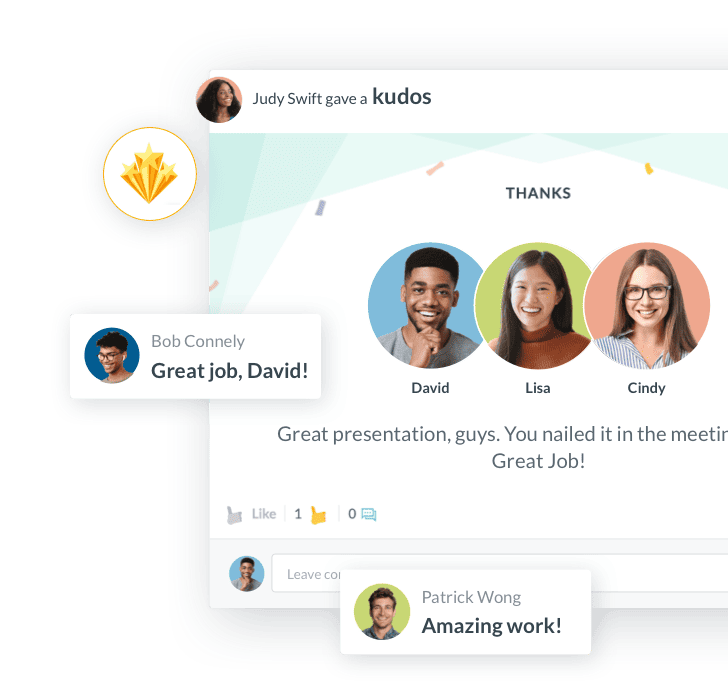
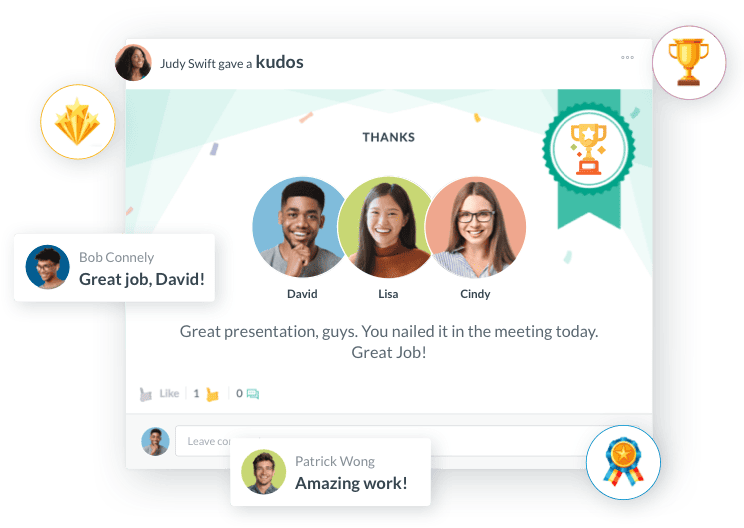
Salesforce: Social, Visible, and Integrated Recognition
Salesforce is a global leader in customer relationship management (CRM), with over 70,000 employees worldwide. Known for its strong emphasis on values like trust, customer success, and equality, Salesforce builds recognition into the fabric of how teams work.
Key Recognition Program: “Thanks” Badges in Chatter
Salesforce employees regularly use Chatter, the company’s internal collaboration tool, to share “Thanks” badges. These are public, value-linked recognitions that anyone across the org can see and engage with. It's lightweight, social, and searchable. Employees even reference these in performance reviews.
Additional Recognition Efforts
- Slack shoutouts: After acquiring Slack, Salesforce embedded peer praise directly into team channels.
- V2MOM-driven recognition: Employees are recognized for progress tied to company-wide goals (Vision, Values, Methods, Obstacles, and Measures).
- Equality Awards: Celebrating those advancing DEI within the organization.
Why It Works
Recognition is embedded where work happens. In Chatter platform, Slack, and Salesforce dashboards. It’s also linked to performance, not separate from it. And it’s tied to outcomes, ensuring praise connects with impact.
Mini-Template You Can Adapt
|
Element |
Salesforce Approach |
How You Can Adapt |
|
Collaboration Tool |
“Thanks” badges in Chatter |
Use Teams/Slack integrations |
|
Goal Alignment |
Recognition tied to V2MOM objectives |
Link praise to OKRs or quarterly goals |
|
Public Visibility |
All recognitions are searchable and open |
Create a #kudos or #wins channel |
|
DEI Focus |
Equality Awards |
Add inclusive recognition categories |
Apple: Recognition Through Longevity and Quality
Apple is a global tech giant with over 160,000 employees. Known for its product design and innovation, Apple takes a reserved but high-impact approach to recognition.
Its employee recognition programs focused on loyalty, contribution, and precision.
Key Recognition Program: Service Awards
Apple recognizes long-term employees through a series of milestone awards, beginning at 5 years and continuing in 5-year increments.
The most iconic is the 10-year award where a custom aluminum plaque engraved with the employee’s name and Apple’s signature minimalist aesthetic.
Higher milestones (20, 30, 40 years) come with rarer designs and deeper personalization.
Additional Recognition Efforts
- Equity Awards: Top performers receive stock-based incentives, sometimes outside of standard review cycles.
- Apple Events and Retreats: Select teams are invited to internal launch events or design retreats as informal appreciation.
- Apple Design Awards: An event held at WWDC that recognizes innovation, technical excellence, and outstanding user experience in hardware and software design.
Why It Works
Apple's approach to recognition is subtle but powerful. It rewards loyalty, aligns with the company’s design-forward identity, and makes long-term employees feel like part of an elite creative journey. The awards themselves are collector-grade. On brand the way everything about Apple is.
Mini-Template You Can Adapt
|
Element |
Apple’s Approach |
How You Can Adapt |
|
Milestone Gifts |
Custom aluminum plaques every 5 years |
Offer symbolic, high-quality mementos |
|
Equity Awards |
Performance-based stock grants |
Add surprise bonuses outside reviews |
|
Experience-based |
Invitations to launches, retreats |
Celebrate product or team milestones |
|
Quiet Consistency |
Low-noise, high-impact recognition |
Prioritize meaning over visibility |
Airbnb: Recognition Through Freedom, Travel, and Trust
Airbnb designs and sells unique travel experiences worldwide. With around 6,800 global employees, this remote-first company practices what it preaches.
Key Recognition Program: Live & Work Anywhere
In April 2022, CEO Brian Chesky introduced the Live & Work Anywhere policy. Employees can now live and work for up to 90 days in any of 170+ countries, while maintaining compensation and flexibility.
Bonus Travel Credits
Staff also receive a $2,000 annual travel stipend, paid quarterly, to stay at Airbnb listings—encouraging them to use the product firsthand.
Why It Works
- Empowers employees with real-world product experience.
- Enhances loyalty, retention, and brand alignment.
- Serves as a standout talent acquisition advantage; 55% employees used the program in the first year.
Mini-Template You Can Adapt
|
Element |
Airbnb Approach |
How You Can Adapt |
|
Remote Work Flexibility |
Live/work up to 90 days in any country |
Offer periodic geographic work or remote-location days |
|
Product-Use Stipend |
$2,000 annual travel credit |
Provide company service credits or product trials |
|
Global Experience |
Work from diverse locations |
Sponsor retreats or remote-work programs abroad |

Hilton: Recognition Rooted in Hospitality
Hilton is a global hospitality leader with more than 430,000 team members across 7,000+ properties in 123 countries. Its culture revolves around the brand’s stated purpose of filling the earth with the light and warmth of hospitality.
Key Recognition Program: Catch Me at My Best
Every summer, Hilton runs a seasonal program called Catch Me at My Best. Guests, peers, and managers can submit written or digital “catches” to recognize outstanding service.
In one year alone, over 2 million recognitions were submitted globally.
The impact?
Hilton reported a 9.4% improvement in guest satisfaction scores during the program period. Additional Recognition Effort: CEO Light & Warmth Award
This is Hilton’s most prestigious honor, awarded annually to standout team members and teams worldwide. Individual winners receive $10,000, while teams share a collective prize. Winners are selected for embodying Hilton’s core values, often going far beyond their job description to deliver exceptional service.
Why It Works
Hilton’s programs balance everyday praise with formal, high-impact recognition. The initiatives are visible, inclusive, and deeply connected to customer experience. This creates a loop where recognition is tied in to both employee morale and guest satisfaction.
Mini-Template You Can Adapt
|
Element |
Hilton’s Approach |
How You Can Adapt |
|
Peer & Guest Praise |
Catch Me at My Best |
Run seasonal recognition campaigns |
|
High-Level Awards |
CEO Light & Warmth Award |
Create annual spotlight awards by values |
|
Brand Alignment |
Tied to hospitality mission |
Link recognition to your core brand promise |
|
Program Reach |
2M+ recognitions, 100+ countries |
Scale by property, department, or office |
Cisco: Peer Power Meets Performance
Cisco is a global networking and technology company with over 80,000 employees. With a strong focus on collaboration, innovation, and inclusion, Cisco builds recognition into both its cultural DNA and business outcomes.
Key Recognition Program: Connected Recognition
Cisco’s Connected Recognition program is a peer-to-peer platform embedded within its global HR systems.
Employees can recognize colleagues at any level with messages and rewards ranging from $25 to $250. It’s available in over 70 countries and supports multiple languages.
Why It Stands Out
- The program is social, scalable, and value-aligned
- It’s funded at roughly 1% of Cisco’s payroll, demonstrating strong executive support.
Additional Recognition Efforts:
- Bridge Awards: For major cross-functional contributions.
- Moments That Matter: Recognition at key life and career milestones.
- Spotlight features: During all-hands meetings and in internal communications.
Why It Works
Connected Recognition decentralizes praise, while still tying it to business goals. Its global scale, consistent messaging, and financial reinforcement ensure it feels meaningful without overwhelming managers with administrative burden.
Mini-Template You Can Adapt
|
Element |
Cisco’s Approach |
How You Can Adapt |
|
Peer Recognition |
Connected Recognition platform |
Use recognition software or HRIS integrations |
|
Funding Model |
~1% of payroll as dedicated reward pool |
Start with quarterly budget per department |
|
Values Integration |
Every recognition tagged with core value |
Use badges tied to your mission or principles |
|
Global Access |
Multilingual, system-wide participation |
Ensure access across roles and locations |
 Unilever: Recognition That Reflects a Global Workforce
Unilever: Recognition That Reflects a Global Workforce
Unilever is a multinational consumer goods company with over 140,000 employees in more than 190 countries. Its recognition strategy balances global consistency with local flexibility.
Key Recognition Program: MyReward Platform
Unilever’s flagship program is MyReward, a centralized total rewards platform that integrates salary, bonuses, benefits, and recognition.
Employees can send appreciation notes, nominate peers, and access rewards through that one system. It provides visibility into how employees are valued across different regions and roles.
Additional Recognition Effort: Heroes Awards
Each year, Unilever spotlights individuals or teams who go above and beyond through its Heroes Awards. These stories are shared across the organization and reflect extraordinary acts, whether in business delivery, innovation, or social impact.
Why It Works
- Scalable: Works globally while allowing for regional customization.
- Integrated: Combines recognition with pay and benefits.
- Visible: Heroes Awards create storytelling moments that inspire company-wide.
Mini-Template You Can Adapt
|
Element |
Unilever’s Approach |
How You Can Adapt |
|
All-in-One Platform |
Recognition tied into MyReward system |
Integrate recognition with payroll/benefits |
|
Storytelling Awards |
Heroes Awards for outstanding contributions |
Feature monthly hero stories across channels |
|
Regional Flexibility |
Tailored recognition across geographies |
Let local teams adjust rewards or frequency |
Mars: Everyday Recognition at Global Scale
Mars, Incorporated is a global manufacturer of confectionery, pet care, and food products, with more than 130,000 associates across 80+ countries. Its culture is built around the “Five Principles”—Quality, Responsibility, Mutuality, Efficiency, and Freedom.
Key Recognition Program: Ovation
Mars uses a platform called Ovation to power its global employee recognition program. Associates can send shout-outs, celebrate service anniversaries, and nominate peers for higher-level awards through a centralized digital system.
Additional Recognition Efforts
- Achievement Awards: Given to individuals or teams for delivering exceptional results.
- Long-Service Milestones: Celebrated with personalized messages and symbolic gifts.
- On-the-Spot Recognition: Managers and peers can instantly send digital kudos and small rewards.
Why It Works
Mars makes recognition a daily practice, not a quarterly obligation. The Ovation platform enables consistent praise across countries and functions, while tying every form of appreciation back to company values.
Mini-Template You Can Adapt
|
Element |
Mars’ Approach |
How You Can Adapt |
|
Digital Platform |
Ovation for peer and manager recognition |
Use an app or intranet tool to share praise |
|
Value Alignment |
Recognition linked to Mars’ Five Principles |
Anchor programs in your mission or values |
|
On-the-Spot Praise |
Real-time recognition with small rewards |
Give team leads freedom to reward immediately |
|
Tiered Awards |
From thank-you notes to formal achievements |
Create clear levels of recognition |

Google: Recognition That Fuels Innovation
Google, now part of Alphabet Inc., employs over 180,000 people globally. Known for its culture of experimentation and rapid iteration, Google uses both structured and informal recognition to motivate performance and creativity.
Key Recognition Program: gThanks
Google’s internal tool, gThanks, lets employees send peer-to-peer appreciation via email or intranet. These messages are visible to the recipient’s manager and sometimes included in performance reviews. They are also pinned on Wall of Happiness for all to see.
The simplicity and reach of the system make it widely adopted.
Additional Recognition Efforts
- Peer Bonuses: Googlers can nominate a colleague for a cash bonus (typically $100–$200) for exceptional work.
- Manager Awards: Bonuses and equity grants are also distributed during performance cycles based on 360-degree feedback.
- Recognition Moments: Informal praise is encouraged during team standups, town halls, and product demos.
Why It Works
Google keeps recognition lightweight, timely, and merit-based.
Employees don’t need permission to appreciate someone. And the option to award real money, especially from peers, makes recognition feel more meaningful and earned.
Mini-Template You Can Adapt
|
Element |
Google’s Approach |
How You Can Adapt |
|
Peer-to-Peer Thanks |
gThanks notes recorded and shared |
Set up email-based or intranet recognition |
|
Bonus Nominations |
Peer-submitted bonuses ($100–$200) |
Allocate small monthly budget for nominations |
|
Public Praise |
Shout-outs at standups and town halls |
Make recognition part of weekly rituals |
|
Integration with Reviews |
Recognition impacts performance feedback |
Log praise for quarterly check-ins or reviews |
Employee Recognition at a Glance (Comparison Table)
This quick-reference table highlights how each company approaches employee recognition.
|
Company |
Primary Format |
Platform/Tool |
Recognition Type |
Notable Feature |
|
Disney |
Peer-to-peer + milestone |
RecognizeNow! |
Daily + service-based |
Guest-initiated compliments via mobile app |
|
Zappos |
Peer-to-peer |
Zollars + Culture Book |
Daily + surprise bonuses |
Employees redeem peer-awarded “Zollars” |
|
Salesforce |
Social + goal-aligned |
Chatter, Slack |
Real-time + values-based |
Recognition tied to performance goals (V2MOM) |
|
Apple |
Tenure + symbolic |
Internal ceremonies |
5 – 40 year service awards |
Minimalist aluminum plaques signed by leadership |
|
Airbnb |
Experience-based |
Travel credits + notes |
Quarterly + flexible |
$2K annual travel stipend to use company service |
|
Cisco |
Peer-to-peer + formal |
Connected Recognition |
Real-time + funded |
1% of payroll allocated to global recognition |
|
Unilever |
Centralized + storytelling |
MyReward + Heroes Awards |
Ongoing + annual |
Rewards integrated with total compensation |
|
Mars |
Daily + achievement-based |
Ovation |
On-the-spot + formal |
Consistent global delivery of recognition |
|
|
Peer + bonus enabled |
gThanks + peer bonus |
Asynchronous + monetary |
Peers nominate each other for real cash bonuses |
|
Hilton |
Guest + peer + annual |
Catch Me + CEO Award |
Seasonal + prestigious |
Over 2M guest and peer recognitions in one year |
Strategic Takeaways from Company Recognition Programs
Across all 10 companies, a few powerful patterns emerge. These aren’t just one-off initiatives. They’re part of a broader strategy to retain talent, reinforce values, and create high-performing cultures.
-
Peer-to-Peer Recognition Is Here to Stay: From Cisco’s Connected Recognition to Zappos’ Zollars and Google’s gThanks, employees are empowered to recognize one another directly. This fosters a culture of camaraderie, ownership and shared appreciation.
-
Values Drive the Praise: Salesforce, Mars, and Unilever make recognition meaningful by tying it back to company values. Whether through badges, award nominations, or peer shoutouts, what gets recognized reinforces what matters most.
-
Design a Program that Fits Your Culture: Hilton and Salesforce use highly visible, public programs. Apple and Google lean toward quiet, internal recognition. There’s no single formula. The best approach should be as per your team’s comfort level and brand tone.
-
Milestone Moments Still Matter: While frequent feedback is essential, formal milestone celebrations remain impactful. Disney, Apple, and Mars all highlight long-term service and special achievements through symbolic awards or events.
-
Recognition Doesn’t Have to Mean Cash: While some companies offer monetary bonuses, many build value through experiences (Airbnb), visibility (Hilton), or storytelling (Zappos, Unilever). Thoughtful, well-timed praise often outweighs the dollar amount.
DIY Company Recognition Checklist
Ready to put these lessons into action?
Here’s a simple checklist to help you design a recognition program tailored to your company’s size, values, and goals.
Audit What Exists
- Do you currently have any informal or formal recognition in place?
- Is it consistent across teams or locations?
- Are employees aware of it—and using it?
Define What You’ll Recognize
- Link recognition to your core values or strategic goals.
- Decide which behaviors or milestones you want to reinforce—collaboration, innovation, customer delight?
Choose Recognition Formats
- Mix and match based on team needs:
- Peer-to-peer shoutouts
- Manager-led awards
- Anniversary or milestone gifts
- Customer-submitted praise
- Decide whether it will be digital, in-person, or both.
Set a Cadence
- Will recognition be daily, weekly, monthly, or ad hoc?
- Who will manage it - HR, team leads, or everyone?
Track and Adjust
- Use simple KPIs like:
- % of employees giving or receiving recognition
- Participation by department or manager
- Retention rates or eNPS score shifts
- Collect feedback and iterate regularly.
Next Steps & Resources
You've seen how top companies from Disney to Google recognize employees in ways that align with their culture, values, and business goals.
But you don’t need a global budget or a custom-built tool to get started.
Download this free Employee Recognition Program Starter Kit to get you started immediately.
Workmates by HR Cloud gives you everything you need to launch a recognition program that works, right out of the box.
Whether you're looking to enable peer-to-peer shout-outs like Zappos, automate milestone celebrations like Apple, or run values-based awards like Cisco or Unilever, Workmates supports it all.
You can:
- Share digital kudos and public praise in real time
- Celebrate birthdays and work anniversaries automatically
- Align recognition with core company values using customizable badges
- Track participation and engagement with built-in analytics
- Encourage team-wide participation with leaderboard and reward options
Recognition becomes part of daily work and not another HR task to be done.
Want to see it in action?
👉 Take a self-guided Workmates tour
👉 Book a free 1:1 demo with our team
FAQs
What is an example of employee recognition?
Publicly praising an employee for solving a tough customer issue during a team meeting is a simple yet powerful example. It reinforces good work and boosts morale.
What is an example of recognition?
A handwritten thank-you note from a manager after a successful product launch. It shows appreciation without needing a formal program.
What is an example of a recognition system?
A company-wide platform where employees send digital badges and nominate peers for monthly awards. It formalizes and tracks recognition across teams.
What is recognition type and example?
Recognition types include peer-to-peer, manager-led, milestone, and performance-based. For example, a spot bonus for exceeding targets is performance-based recognition.
What are recognition systems?
These are structured programs or tools that support employee appreciation. For instance, e-card platforms, service award trackers, or peer reward portals.
What is an example of a recognition statement?
“Thank you for staying late to finish the proposal. It made a big difference to the team.” This is an example of short, specific recognition statements.

Keep Reading
25 Employee Incentive Programs to Boost Engagement and Retention
What are employee incentive programs? Employee incentive programs are structured systems
100 Icebreaker Questions for Work That Build Lasting Team Connections
Strong teams don't emerge from org charts—they're built through authentic human
Company Core Values Examples: 25 Inspiring Ways to Build Culture Through Recognition
Company core values shape every interaction in your workplace - from how decisions get
Like What You Hear?
We'd love to chat with you more about how HR Cloud® can support your business's HR needs. Book Your Free Demo

Build a Culture of Recognition. Boost Engagement. Guaranteed.
Workmates empowers employees to stay informed, connected, and appreciated—whether they’re on the front line, in the office, or remote. Recognition drives 12x higher engagement.Trusted by industry leaders in every sector




Cut Onboarding Costs by 60%.
Take the confusion and follow-ups out of onboarding with automated workflows, digital forms, and structured portals—so new hires ramp faster 3X quicker.Trusted by industry leaders in every sector




